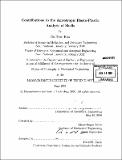| dc.contributor.advisor | Klaus-Jürgen Bathe. | en_US |
| dc.contributor.author | Kim, Do-Nyun | en_US |
| dc.contributor.other | Massachusetts Institute of Technology. Dept. of Mechanical Engineering. | en_US |
| dc.date.accessioned | 2009-11-06T16:31:05Z | |
| dc.date.available | 2009-11-06T16:31:05Z | |
| dc.date.copyright | 2009 | en_US |
| dc.date.issued | 2009 | en_US |
| dc.identifier.uri | http://hdl.handle.net/1721.1/49760 | |
| dc.description | Thesis (Ph. D.)--Massachusetts Institute of Technology, Dept. of Mechanical Engineering, 2009. | en_US |
| dc.description | Includes bibliographical references (p. 133-142). | en_US |
| dc.description.abstract | Shells are probably the most widely used structural component in engineering and also in nature due to their high efficiency and excellent performance when properly designed. On the other hand, they can be very sensitive to changes in geometries, thicknesses, applied loads and boundary conditions. Hence much research effort has been devoted to the reliable and efficient analysis of shells. This work contributes to the anisotropic elasto-plastic analysis of shells by addressing key issues in developing shell elements for finite element analysis and an elasto-plasticity model considering anisotropy and its evolution. First we develop a shell element that models the three-dimensional (3D) effects of surface tractions. The element is the widely used MITC4 shell element enriched by the use of a fully 3D stress-strain description, appropriate through-the-thickness displacements to model surface tractions, and pressure degrees of freedom for incompressible analyses. The element formulation avoids instabilities and ill-conditioning. We also develop a triangular 6-node shell element that represents an important improvement over a recently published element. The element is spatially isotropic, passes the membrane and bending patch tests, contains no spurious zero energy mode, and is formulated without an artificial constant. In particular, the improved element does not show the instability sometimes observed with the earlier published element. | en_US |
| dc.description.abstract | (cont.) Finally we review a constitutive model for anisotropic elasto-plastic analysis which takes into account the anisotropy of both the elastic and plastic material behaviors, as well as their evolution with plastic strains. It is based on continuum energy considerations, the Lee decomposition of deformations and a stored energy function of the logarithmic strains. The present work focuses on giving some physical insight into the parameters of the model and their effects on the predictions in proportional and in non-proportional loading conditions. | en_US |
| dc.description.statementofresponsibility | by Do-Nyun Kim. | en_US |
| dc.format.extent | 142 p. | en_US |
| dc.language.iso | eng | en_US |
| dc.publisher | Massachusetts Institute of Technology | en_US |
| dc.rights | M.I.T. theses are protected by
copyright. They may be viewed from this source for any purpose, but
reproduction or distribution in any format is prohibited without written
permission. See provided URL for inquiries about permission. | en_US |
| dc.rights.uri | http://dspace.mit.edu/handle/1721.1/7582 | en_US |
| dc.subject | Mechanical Engineering. | en_US |
| dc.title | Contributions to the anisotropic elasto-plastic analysis of shells | en_US |
| dc.type | Thesis | en_US |
| dc.description.degree | Ph.D. | en_US |
| dc.contributor.department | Massachusetts Institute of Technology. Department of Mechanical Engineering | |
| dc.identifier.oclc | 456732069 | en_US |
